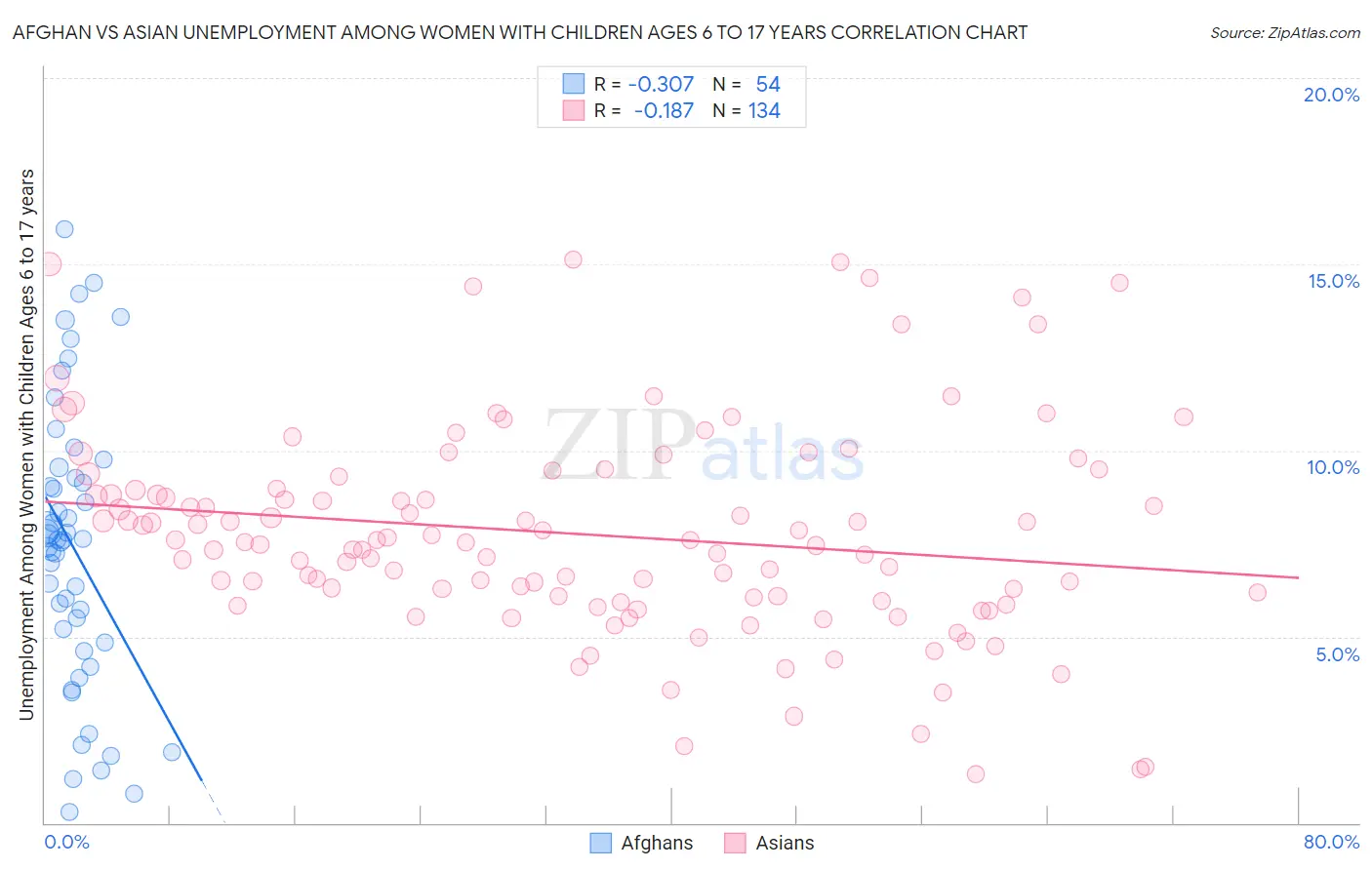Afghan vs Asian Unemployment Among Women with Children Ages 6 to 17 years
COMPARE
Afghan
Asian
Unemployment Among Women with Children Ages 6 to 17 years
Unemployment Among Women with Children Ages 6 to 17 years Comparison
Afghans
Asians
7.6%
UNEMPLOYMENT AMONG WOMEN WITH CHILDREN AGES 6 TO 17 YEARS
100.0/ 100
METRIC RATING
18th/ 347
METRIC RANK
8.0%
UNEMPLOYMENT AMONG WOMEN WITH CHILDREN AGES 6 TO 17 YEARS
100.0/ 100
METRIC RATING
37th/ 347
METRIC RANK
Afghan vs Asian Unemployment Among Women with Children Ages 6 to 17 years Correlation Chart
The statistical analysis conducted on geographies consisting of 127,639,249 people shows a mild negative correlation between the proportion of Afghans and unemployment rate among women with children between the ages 6 and 17 in the United States with a correlation coefficient (R) of -0.307 and weighted average of 7.6%. Similarly, the statistical analysis conducted on geographies consisting of 355,293,130 people shows a poor negative correlation between the proportion of Asians and unemployment rate among women with children between the ages 6 and 17 in the United States with a correlation coefficient (R) of -0.187 and weighted average of 8.0%, a difference of 5.1%.

Unemployment Among Women with Children Ages 6 to 17 years Correlation Summary
| Measurement | Afghan | Asian |
| Minimum | 0.30% | 1.3% |
| Maximum | 15.9% | 15.1% |
| Range | 15.6% | 13.8% |
| Mean | 7.4% | 7.8% |
| Median | 7.6% | 7.5% |
| Interquartile 25% (IQ1) | 4.8% | 6.0% |
| Interquartile 75% (IQ3) | 9.3% | 9.0% |
| Interquartile Range (IQR) | 4.4% | 2.9% |
| Standard Deviation (Sample) | 3.8% | 2.8% |
| Standard Deviation (Population) | 3.7% | 2.8% |
Demographics Similar to Afghans and Asians by Unemployment Among Women with Children Ages 6 to 17 years
In terms of unemployment among women with children ages 6 to 17 years, the demographic groups most similar to Afghans are Filipino (7.6%, a difference of 0.020%), Cambodian (7.5%, a difference of 0.65%), Immigrants from Singapore (7.7%, a difference of 1.0%), Immigrants from India (7.7%, a difference of 1.2%), and Immigrants from China (7.7%, a difference of 1.5%). Similarly, the demographic groups most similar to Asians are Burmese (8.0%, a difference of 0.030%), Immigrants from South Central Asia (7.9%, a difference of 0.11%), Native Hawaiian (7.9%, a difference of 0.22%), Immigrants from Korea (7.9%, a difference of 0.50%), and Immigrants from Cambodia (7.9%, a difference of 0.55%).
| Demographics | Rating | Rank | Unemployment Among Women with Children Ages 6 to 17 years |
| Cambodians | 100.0 /100 | #17 | Exceptional 7.5% |
| Afghans | 100.0 /100 | #18 | Exceptional 7.6% |
| Filipinos | 100.0 /100 | #19 | Exceptional 7.6% |
| Immigrants | Singapore | 100.0 /100 | #20 | Exceptional 7.7% |
| Immigrants | India | 100.0 /100 | #21 | Exceptional 7.7% |
| Immigrants | China | 100.0 /100 | #22 | Exceptional 7.7% |
| Immigrants | Indonesia | 100.0 /100 | #23 | Exceptional 7.7% |
| Nepalese | 100.0 /100 | #24 | Exceptional 7.7% |
| Immigrants | Eastern Asia | 100.0 /100 | #25 | Exceptional 7.7% |
| Indians (Asian) | 100.0 /100 | #26 | Exceptional 7.7% |
| Immigrants | Afghanistan | 100.0 /100 | #27 | Exceptional 7.8% |
| Immigrants | Uzbekistan | 100.0 /100 | #28 | Exceptional 7.8% |
| Thais | 100.0 /100 | #29 | Exceptional 7.8% |
| Immigrants | Iran | 100.0 /100 | #30 | Exceptional 7.9% |
| Laotians | 100.0 /100 | #31 | Exceptional 7.9% |
| Immigrants | Cambodia | 100.0 /100 | #32 | Exceptional 7.9% |
| Immigrants | Korea | 100.0 /100 | #33 | Exceptional 7.9% |
| Native Hawaiians | 100.0 /100 | #34 | Exceptional 7.9% |
| Immigrants | South Central Asia | 100.0 /100 | #35 | Exceptional 7.9% |
| Burmese | 100.0 /100 | #36 | Exceptional 8.0% |
| Asians | 100.0 /100 | #37 | Exceptional 8.0% |